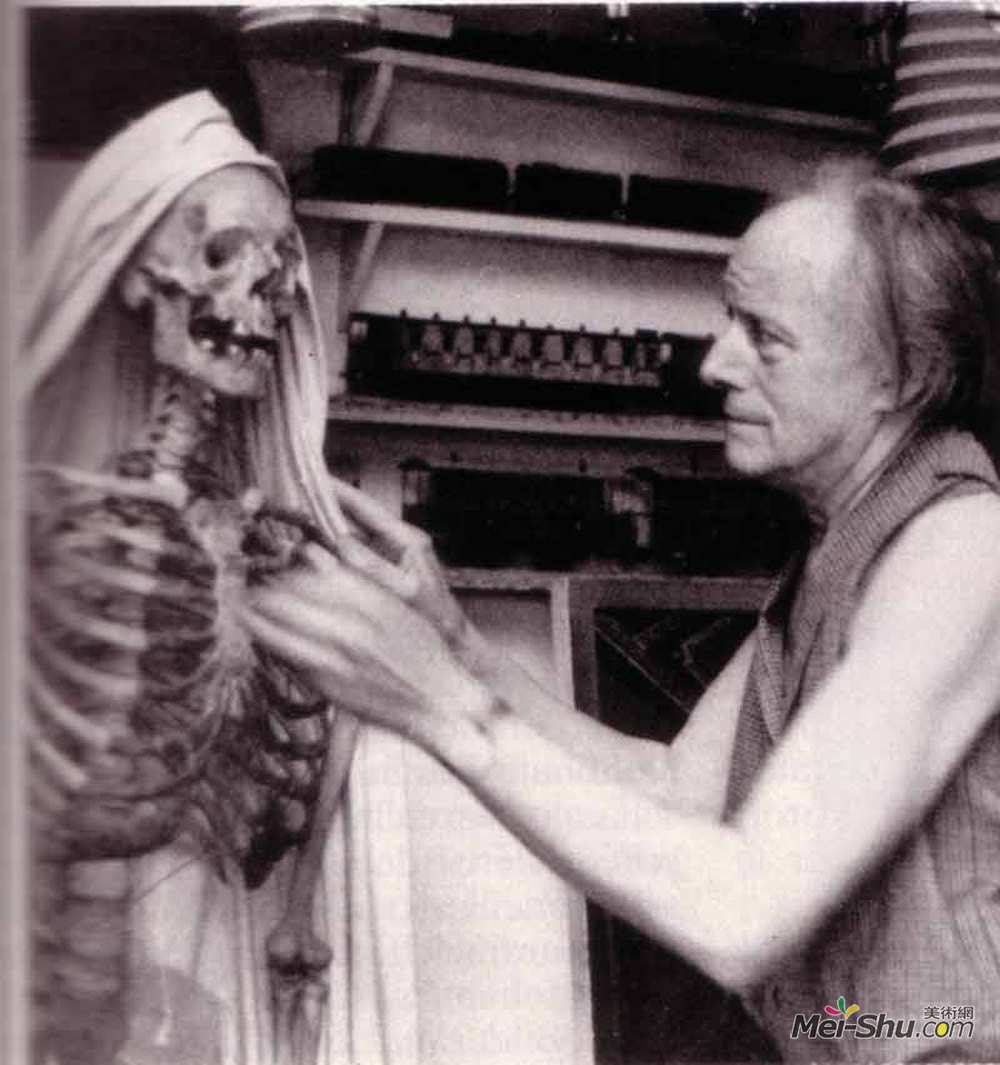
保罗·德尔沃(Paul Delvaux)
艺术家: 保罗·德尔沃
生于: 1897年9月23日;安西特,比利时
卒于: 1994年7月20日;比利时Veurne
国籍: 比利时
流派: 超现实主义
领域: 绘画
受影响: Edouard Riou
机构: 皇家美术学院(亚-欧空局),布鲁塞尔,比利时
保罗·德尔沃是一位比利时艺术家,他的油画以超现实主义元素与古典形式相融合而闻名。在德尔沃的作品中,一个反复出现的主题是裸体女性,处于各种不同的位置,在古典建筑或火车站中静静地徘徊,结合了诸如骷髅、儒勒·凡尔纳小说中的人物、戴着圆顶礼帽的男子和其他意想不到的物品。在乔治·德·奇里科和任安培·马格里特的作品的深刻影响下,德尔沃的场景以长长的阴影和明显的焦虑和不安为特征。
德尔沃对探索人类和潜意识感兴趣。虽然他最初发现表现主义的灵感,他的成熟风格主要受超现实主义运动的影响。在1930年间,德尔沃开始探索一种为诗歌创作而开发的超现实主义技术。这种抽搐结合的技术,类似于自动化,但是具有更高的顺序,是超现实主义者为了通过切割和重新配置文本来创作拼贴诗而实践的。德尔沃追求一种与此技术相当的视觉效果。他通过将彼此无关的主题、地点和想法合并在一起实现了这一点。通过这样做,他创造了奇异的新世界,充满了强烈的怀旧感,疏离感,以及对失去孩子般的想象自由的悲伤。
尽管事实上Delvaux和许多超现实主义画家保持着专业和个人的关系,包括安博士和233岁;布雷顿,仁和233;玛格丽特和Paul Eluard,他保持独立,不认为自己是超现实主义者。此外,Delvaux声称发现弗洛伊德'的精神分析思想,形成了超现实主义运动,对他的工作不重要。在1930年底访问意大利后,建筑不仅仅是他的绘画背景。他在旅途中遇到的古典建筑,城市广场,以及他对火车站的终生痴迷,成了他神秘场景的舞台,对于实现这些场景的特殊情绪至关重要。赤裸的身体与建筑形成鲜明对比的苍白,暴露出矛盾的元素:公共和私人空间,活体和冰冷的无生命的石头,以及他画中人物的疏远和色情的一面。这种对比随着戴着圆顶礼帽(R.Magritte的影响)和裸体一起出现的男人的外表而更加明显。
战后几年,Delvaux对童年的痴迷再次出现。他对骷髅的恐惧变成了迷恋。除了他的裸体,保罗·德尔沃故意使骨架在他不寻常的框架中显得不合适。他摆出栩栩如生的姿势,斜倚着或徘徊着,相信他们与他富有想象力的环境相联系时,会带来一种生命感和时间感。他小时候对有轨电车和火车的热爱也出现在他后来的许多作品中,如此之多,使他赢得了“车站画家”的昵称。从20世纪50年代初开始,他在比利时(在刚果宫殿,在李安普格动物研究所,以及在布鲁塞尔的Bourse车站)创作了许多大型壁画。德尔沃被任命为比利时皇家美术学院院长和院长,1973年,他被授予约翰·沃尔夫冈·冯·歌德·斯蒂夫顿伦勃朗奖。在他的最后几年里,他的视力变得很差,被迫放弃绘画。
Artist :Paul Delvaux
Additional Name :Paul Delvaux
Born : Antheit, Belgium
Died : Veurne, Belgium
Nationality :Belgian
Art Movement :Surrealism
Influenced by :edouard-riou
Art institution :Académie Royale des Beaux-Arts (ARBA-ESA), Brussels, Belgium
Paul Delvaux was a Belgian artist known for his oil paintings that merge the elements of Surrealism with classical forms. A reoccurring theme in Delvaux’s work are nude women, in various positions, wandering silently through classical buildings or train stations, combined with motifs such as skeletons, characters from Jules Verne novels, men wearing bowler hats, and other unexpected objects. Deeply influenced by the works of Giorgio de Chirico and René Magritte, Delvaux’s scenes are characterized by long shadows and a distinct sense of anxiety and unease.
Delvaux was interested in exploring humanity and the subconscious. While he initially found inspiration in Expressionism, his mature style was mainly influenced by the Surrealist movement. During the 1930’s Delvaux began exploring a technique Surrealists developed for making poetry. This technique of convulsive joining, similar to automatism but with a higher level of order, was practiced by Surrealists in order to create collage poetry by cutting and reconfiguring the text. Delvaux pursued the idea of finding a visual equivalent to this technique. He achieved this by merging together subjects, places, and ideas that were unrelated to each other. In doing so, he created bizarre new worlds infused with a strong sense of nostalgia, alienation, and a feeling of sadness for the loss of childlike imaginative freedom.
Despite the fact that Delvaux maintained a professional and personal relationship with many Surrealist painters including André Breton, René Magritte, and Paul Eluard, he remained independent and did not consider himself a Surrealist. Moreover, Delvaux claimed to find Freud's psychoanalytic ideas, that shaped the Surrealist movement, unimportant for his work. After his visit to Italy in the late 1930’s, architecture became much more than just a background in his paintings. The classical buildings he came across on his voyage, the city squares, and his lifelong obsession of train stations became a stage for his mysterious scenes, essential to achieving their specific moods. The contrasting paleness of the naked bodies against the architecture brought to light contradictory elements: public and private sphere, living bodies and the cold inanimate stone, and the estranged and the erotic side of his painted figures. This contrast was even more enhanced with the appearance of a man wearing a bowler hat (influence of R. Magritte) alongside the nudes.
The post-war years saw the re-emergence of Delvaux‘s childhood obsessions. His fear of skeletons turned into fascination. As well as his nudes, Delvaux purposely made the skeletons appear out of place in his unusual framework. He showed them in lifelike poses, reclining or lingering, believing that they brought a sense of life and time when connected with his imaginative settings. His childhood love of trams and trains also appeared in many of his later works, so much so, that it earned him the nickname "The Painter of Stations."
In later life, Delvaux received many distinctions while still continuing to execute important works. From the early 1950’s he created a number of large murals in Belgium (at the Palais des Congrès, at the Liège Institute of Zoology, and in the Bourse station in Brussels). Delvaux was named the president and director of the Académie Royale des Beaux-Arts in Belgium and in 1973, he was awarded the Rembrandt Prize of the Johann Wolfgang von Goethe Stiftung. In his final years, his vision became so poor that he was forced to give up painting.